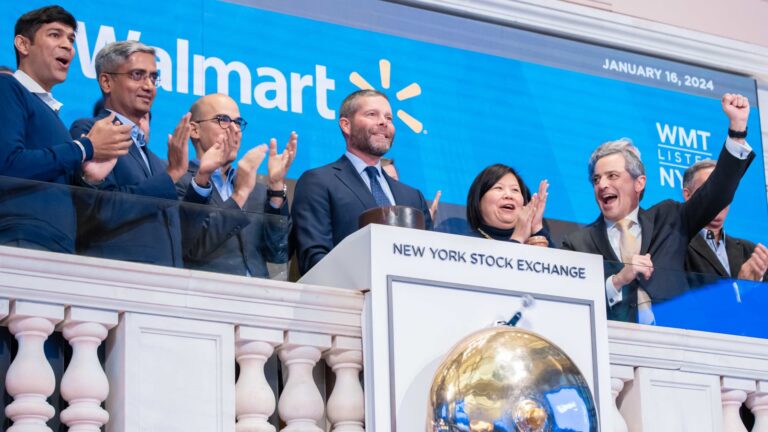
Walmart on Thursday topped quarterly earnings and revenue expectations, as the discounter made significant e-commerce gains, drove profits with newer businesses like advertising and won over more high-income shoppers.
The big-box retailer said it now expects to hit the high end or slightly top its previous full-year guidance. Walmart had expected net sales growth of 3% to 4% and adjusted earnings per share of between $2.23 and $2.37.
Shares of the company rose about 6% and hit an all-time high in early trading.
In an interview with CNBC, Chief Financial Officer John David Rainey said one of the factors boosting Walmart’s grocery business is the widening gap between the price of cooking at home and buying food at fast-food chains or restaurants.
Plus, he added, shoppers appreciate the convenience that Walmart offers. For the first time, its delivery business surpassed its store pickup in terms of volume, Rainey said.
“We’ve got customers that are coming to us more frequently than they have before and newer customers that we haven’t traditionally had, and they’re coming into a Walmart whether it’s a virtual store online, or whether it’s one of our physical stores,” Rainey said.
Here’s what the discounter reported for the fiscal first quarter compared with what Wall Street expected, according to a survey of analysts by LSEG:
- Earnings per share: 60 cents adjusted vs. 52 cents expected
- Revenue: $161.51 billion vs. $159.50 billion
Walmart’s net income jumped to $5.10 billion, or 63 cents per share, in the three-month period that ended April 30, compared with $1.67 billion, or 21 cents per share, in the year-ago period.
Revenue climbed 6% from $152.30 billion in the year-ago quarter. That increase includes a benefit of roughly 1% from an additional selling day in the period.
Walmart shares rose about 5% in premarket trading Thursday.
The New York Stock Exchange welcomes Walmart (NYSE: WMT), today, Tuesday, January 16, 2024, in recognition of the International CFO Summit. To honor the occasion, John David Rainey, Executive Vice President & Chief Financial Officer, joined by Chris Taylor, Vice President, NYSE Listings and Services, rings The Opening Bell®.
NYSE
As the nation’s largest retailer and private employer, Walmart is often viewed as a bellwether for the U.S. economy. Yet it has generally fared better during an inflationary period than other retailers because it sells staples like groceries and has a value-oriented reputation.
Same-store sales for Walmart U.S. climbed by 3.8%, excluding fuel. The industry metric includes sales from stores and clubs open for at least a year. At Sam’s Club, same-store sales rose 4.4% year over year, excluding fuel.
E-commerce sales shot up by 22% year over year for Walmart U.S., fueled by store pickup and delivery of online orders, as well as the company’s growing third-party marketplace.
Walmart’s customers in the U.S. made more visits to its stores and website in the quarter, but spent roughly the same as in the…
Read More: Walmart (WMT) Q1 2025 earnings



